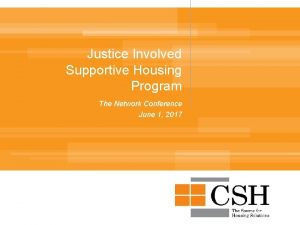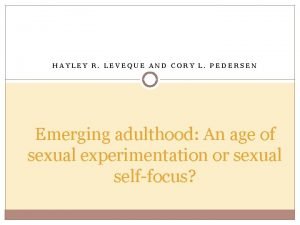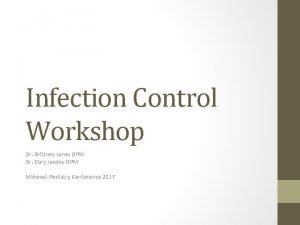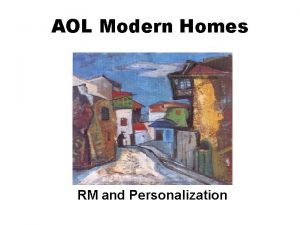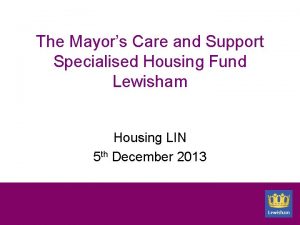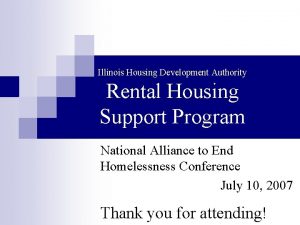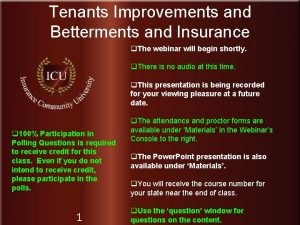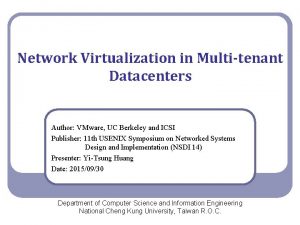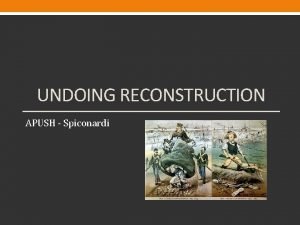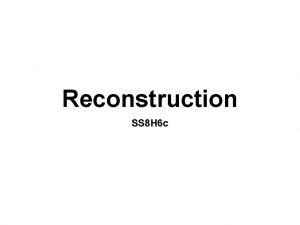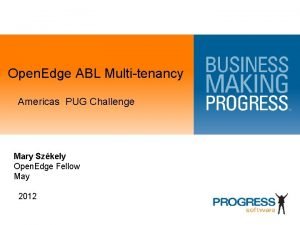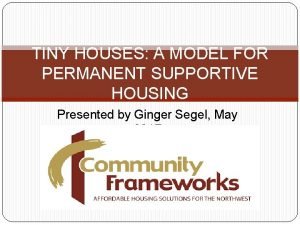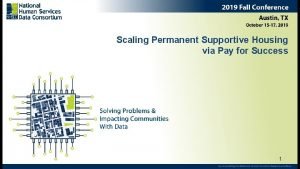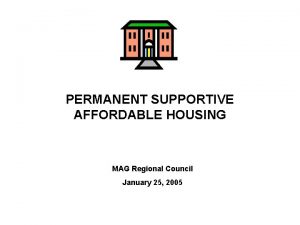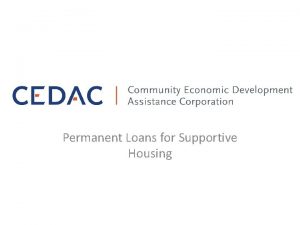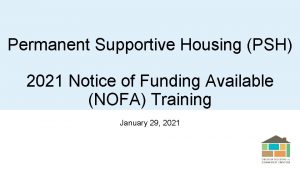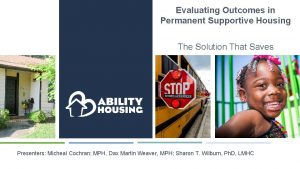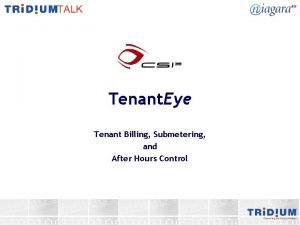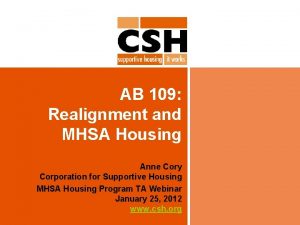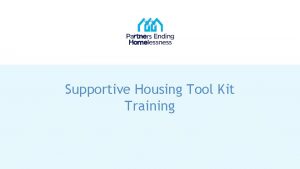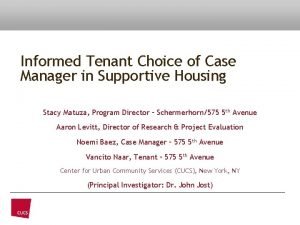Tenant Support in Permanent Supportive Housing Anne Cory

































- Slides: 33

Tenant Support in Permanent Supportive Housing Anne Cory Corporation for Supportive Housing MHSA Operations TA Call August 4, 2010 www. csh. org

Tenant Support in Permanent Supportive Housing Agenda n Making the transition to PSH n Supporting tenants in their new home n Soliciting tenant input n Creating structures for tenant involvement n Tenant Leadership n Hiring tenants as staff n Tools to help 2

Making the transition to PSH Homelessness involves more than just the loss of a home n Understand the impact of loss and homelessness n Impact on transition into permanent housing n Prepare people to succeed in housing 3

Making the transition to PSH n 4 Once people move into housing they may temporarily experience relapse and/or psychiatric decompensation: be prepared for such crises

Supporting tenants in their new home n n 5 Help tenants define their housing and service goals Establish clear policies and procedures Clarify expectations of tenancy Orient residents to their new home

Supporting tenants in their new home Help tenants get “in the driver’s seat” n Exploring the resident’s housing preferences sends the message that the decision-making process is mutual and not a directive from the worker. It also provides valuable information to the worker about the resident’s expectations. 6

Supporting tenants in their new home Help tenants get “in the driver’s seat” n We must not underestimate the importance of hope and its impact in supporting residents’ ability to achieve the goal of accessing housing. n Many residents who have succeeded in securing and maintaining housing point out that someone believed in them even if they had given up believing in themselves. 7

History of Community Building in Supportive Housing n 8 Fostering positive supportive relationships among tenants resulted in a greater sense of belonging, enhanced self-esteem, increased use of social services, decreased isolation, provided increased safety and for some, more confidence to engage in other relationships outside the residence.

Community Building Community building involves a range of activities, which include: n connecting tenants to each other n connecting tenants to the staff n connecting tenants/the program to the neighborhood and the community at large 9

Soliciting tenant input and Creating structures for tenant involvement

Why involve tenants in decision making? n n n n 11 Sense of ownership in the community Empowerment and skill building Build relationships Develop trust Encourage shared responsibility Develop consensus Support tenant-driven community norms

How are tenants’ views incorporated into your programs? n n n n 12 One-on-one discussions eliciting tenants’ opinions Community meetings Tenant surveys Focus groups Advisory committees Tenant councils Hiring tenants as staff

Involving and Empowering Tenants Hold community meetings § Serve as a forum for community announcements § Gather viewpoints and suggestions § Help troubleshoot issues, dispel rumors and share information § Educate tenants on operating costs issues § Educate management on tenant concerns and priorities 13

Involving and Empowering Tenants Tenant Surveys n Determine how to meet tenants’ needs n Assess effective ways to offer support services n Gather ideas for program improvement 14

Involving and Empowering Tenants Hold focus groups n Focus groups of current and former tenants can provide valuable input n Use to gather information on specific issues n Use skilled facilitator 15

Involving and Empowering Tenants Create a Tenant Council § § 16 Gives a voice to tenants Provides a forum for tenants to advocate on their own behalf Provides environment for tenants to develop leadership and advocacy skills Provides opportunity for tenants to make and carry out meaningful decisions

Involving and Empowering Tenants Create A Tenant Advisory Committee § Serves as liaison between tenants and management § Open lines of communication § Can address a specific issue or provide recommendations to board on an ongoing basis 17

Involving and Empowering Tenants Use teamwork n Create partnership of staff and residents to address issues together (shift from “doing for” to doing with”) n Communicate to tenants that their input is valued n Supports self-efficacy among tenants n Ensure training for tenants and staff to help this approach work 18

Involving and Empowering Tenants Support tenant-driven community norms within single-site projects n Norms are informal rules for behavior and culture in a housing site n Tenant input in establishing norms creates greater support 19

Involving and Empowering Tenants Hire tenants as peers and/or support peer-run programs n Peer support is an essential component of a supportive network for people living with mental illness n Communicates the potential for recovery n Benefits tenants and housing providers n Improves effectiveness of engagement n Peer employees can fill designated positions or mainstream positions 20

CSH Dimensions of Quality Dimension #6: Tenant Rights, Input and Leadership n 21 Definition: Tenant rights are protected within consistently-enforced policies and procedures, tenants are provided with meaningful input and leadership opportunities, and staff relationships with tenants are characterized by respect and trust.

CSH Dimensions of Quality Key Indicators of Quality: n All involved organizations actively seek tenant input in decision-making at their highest organizational levels, support tenants in forming tenant councils, and meet regularly with any tenant-led organizations. 22

CSH Dimensions of Quality Assessing Key Indicators of Quality: n Questions to Consider: – What efforts have been made to support tenants in forming tenant councils or other tenant-led organizations? – Do tenant input opportunities result in meaningful changes within the involved organizations? 23

Additional Indicators of Quality: Tenant Input and Leadership n n 24 1. Leadership development opportunities for tenants are created and/or supported by all partners. 2. Tenants are provided with regular opportunities to provide input regarding all policies related to tenant and consumer rights. 3. Tenants are provided with regular opportunities to provide input regarding the design, development, and delivery of supportive services. 4. Tenants who participate in leadership development and input opportunities are protected by a “no-retaliation” policy.

Meaningful Tenant Involvement Tenant involvement criteria: n Participation must meet real needs and create real results. n Don’t ask for resident input if you aren’t willing to take it seriously and devote time to addressing resident concerns. n To be true “partners” in the building’s success, residents need to understand the financial and other constraints of the project, and they need to participate in setting the building’s goals. 25

Meaningful Tenant Involvement n n n 26 Try to have some resources available to meet resident requests or implement resident ideas. A convenient on-site meeting space increases participation enormously. Democratic leadership skills are not widely taught in our culture. Try to make organizing and training resources available to residents to give them the skills to conduct good meetings and create an accountable organization.

Introduction to Tools

Tools Internal: n Tenant Welcome Manual n Tenant education (tenancy issues, clinical issues) External: n NAMI Housing Toolkit n SAMHSA Evidence-Based Practices KIT: Permanent Supportive Housing – Tools for Tenants 28

Tools Tenant Welcome Manual n Agency/Program Background n Building Procedures n House Rules and Consequences n Rent Collection n Community Amenities and Resources n Grievance Procedures n Security and Emergency Procedures n Supportive Services n Tenant Council 29

NAMI Housing Toolkit n n 30 A Housing Toolkit: Information to help the public mental health community meet the housing needs of people with mental illnesses Available at www. nami. org

Tools Education for Tenants n SAMHSA Tool KITS for information to educate tenants and families about strategies for coping with psychiatric disabilities. n Includes “Tools for Tenants” in the Permanent Supportive Housing KIT http: //mentalhealth. samhsa. gov/cmhs/Community Support/toolkits/housing/ 31

Tools Education for Tenants n California Tenants: A Guide to Residential Tenants’ And Landlords’ Rights And Responsibilities, California Department of Consumer Affairs, 2010. Available at http: //www. dca. gov 32

www. csh. org
 Santa clara county office of supportive housing
Santa clara county office of supportive housing Supportive housing providers association
Supportive housing providers association Justice involved supportive housing
Justice involved supportive housing Cory chisholm
Cory chisholm Cory markham
Cory markham Cory foy
Cory foy Cory soto
Cory soto Cory pedersen
Cory pedersen Ujjaval patel
Ujjaval patel Fences act 2 scene 5
Fences act 2 scene 5 Richard cory figurative language
Richard cory figurative language Cory green tea
Cory green tea Eagles 2012 schedule
Eagles 2012 schedule 임지영 토렌트
임지영 토렌트 Cory markham
Cory markham Cory aquino 1986
Cory aquino 1986 Cory tichauer
Cory tichauer Vaccinated and non vaccinated
Vaccinated and non vaccinated Ellen mac cory
Ellen mac cory Modern housing remote support
Modern housing remote support Care and support specialised housing fund
Care and support specialised housing fund Illinois rental housing support program
Illinois rental housing support program Exchange multi tenant control panel
Exchange multi tenant control panel Tenant magic
Tenant magic Tenants improvements insurance
Tenants improvements insurance Vmware multi tenant architecture
Vmware multi tenant architecture Sharecropping
Sharecropping Sharecropping and tenant farming venn diagram
Sharecropping and tenant farming venn diagram Openedge multi-tenant cloud
Openedge multi-tenant cloud Houston sign code
Houston sign code Beran law
Beran law Fsa propaganda
Fsa propaganda Missouri landlord tenant law repairs
Missouri landlord tenant law repairs Tenant rent calculation worksheet
Tenant rent calculation worksheet


